As spring approaches, it’s time to turn our attention to one of the most delectable and nutritious perennial vegetables you can grow in your garden – asparagus! Known for its tender spears and unique flavor, asparagus is a favorite among many gardeners.
In this comprehensive guide, I’ll take you through the benefits of growing asparagus and introduce you to my favorite varieties. By the end, you’ll be well-equipped to start your own asparagus patch and enjoy the rewards for years to come.
Benefits of Growing Asparagus
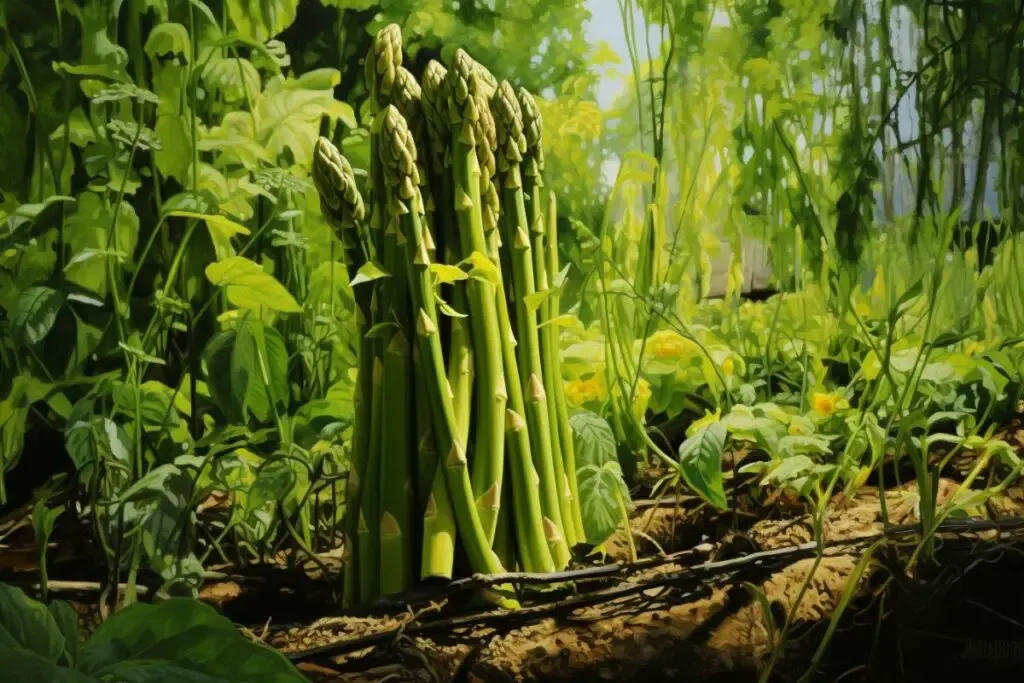
Asparagus isn’t just a tasty addition to your dinner plate; it also offers several benefits that make it a worthwhile addition to your garden.
Let’s explore three of its key advantages:
1. Longevity
Asparagus is a perennial plant, which means that once established, it can produce delicious spears for up to 20 years or more! This longevity is a tremendous advantage for gardeners looking to invest in a crop that will keep on giving season after season.
2. Nutritional Value
Asparagus is not only delicious but also incredibly nutritious. It’s a good source of vitamins A, C, and K, as well as folate and dietary fiber. This green veggie is also low in calories, making it a healthy choice for those looking to maintain a balanced diet.
3. Easy to Freeze
If you find yourself with an abundance of asparagus during the growing season, you can easily freeze it for later use. Simply blanch the spears, cool them, and store them in airtight containers in the freezer. This way, you can enjoy the freshness of homegrown asparagus throughout the year.
My Favorite Asparagus Varieties
Now that you’re aware of the fantastic benefits of growing asparagus, let’s dive into some of my favorite asparagus varieties. Choosing the right variety is crucial to ensure a bountiful harvest and to cater to your specific preferences. Here are three exceptional options:
1. Mary Washington
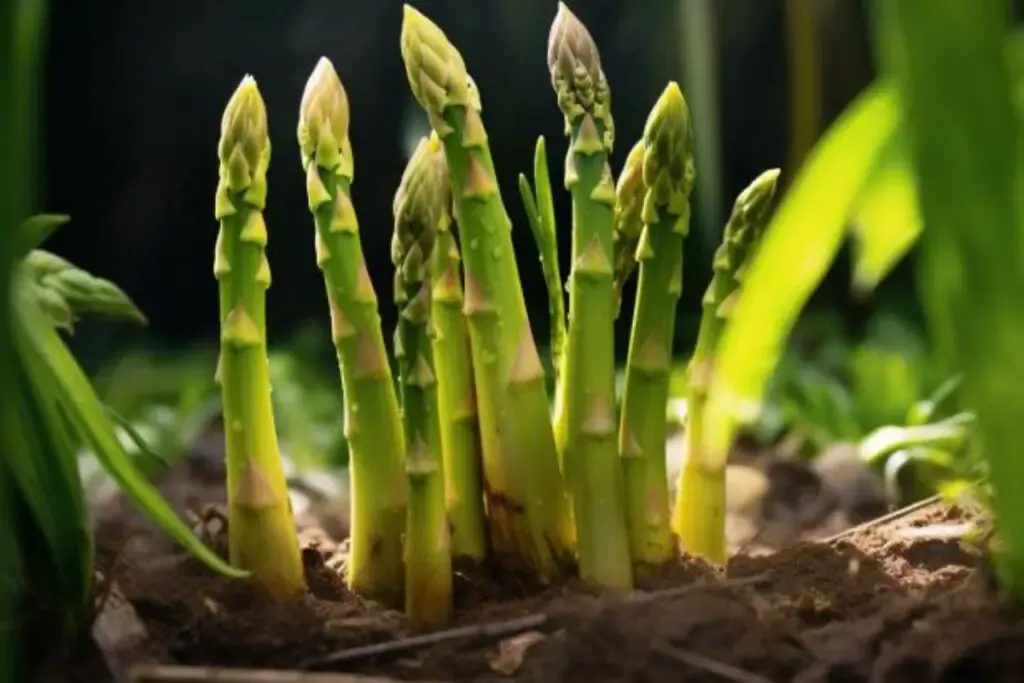
This heirloom variety is a popular choice among asparagus enthusiasts. Mary Washington asparagus produces large, tender, and flavorful spears. It’s well-suited for both home gardens and market gardens. With proper care, you can expect a productive harvest year after year.
2. Purple Passion
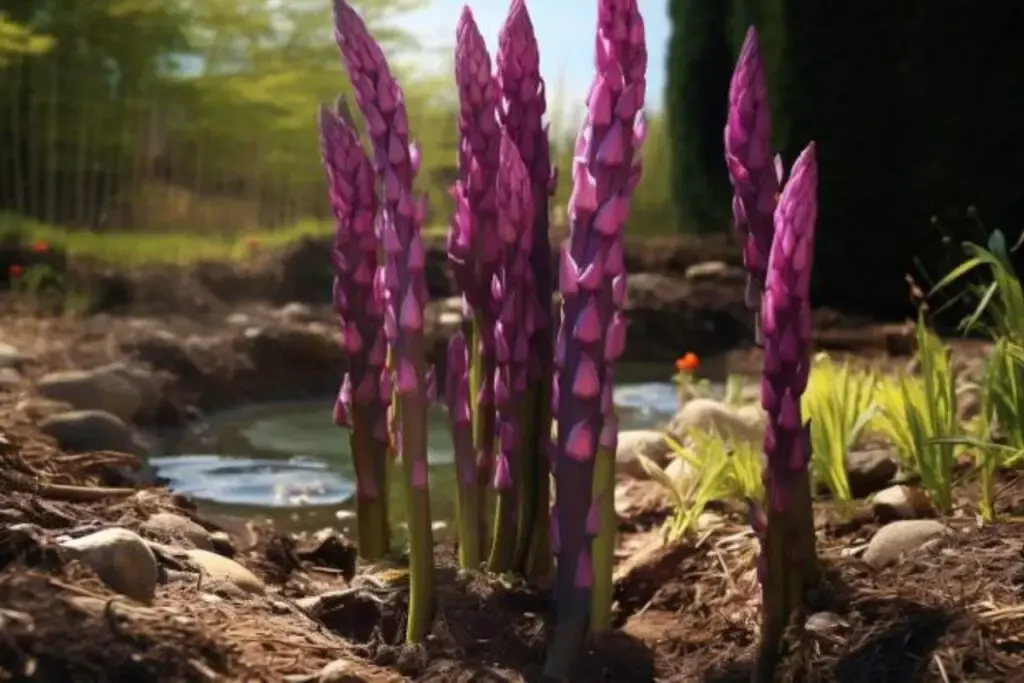
If you’re looking to add a splash of color to your garden and dinner plate, Purple Passion asparagus is the way to go. This variety produces vibrant purple spears that turn green when cooked. The unique color adds visual appeal to your meals, and the flavor is top-notch.
3. Jersey Giant
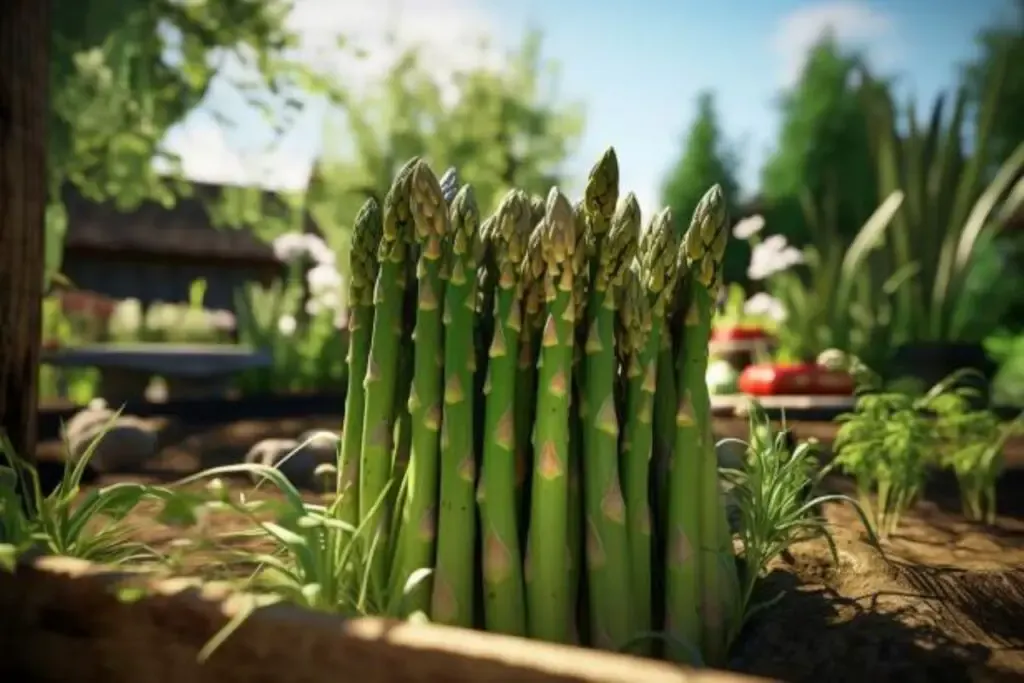
Jersey Giant asparagus is known for its high yields and robust flavor. The spears are thick and tender, making them a favorite for many gardeners. This variety is also disease-resistant, making it a reliable choice for those new to asparagus cultivation.
Asparagus Care
Now that you’re excited about growing asparagus and have selected your favorite varieties, it’s time to dive into the nitty-gritty of caring for your asparagus plants. Proper care ensures a healthy, productive asparagus patch.
Let’s explore the essential aspects of asparagus care.
Planting
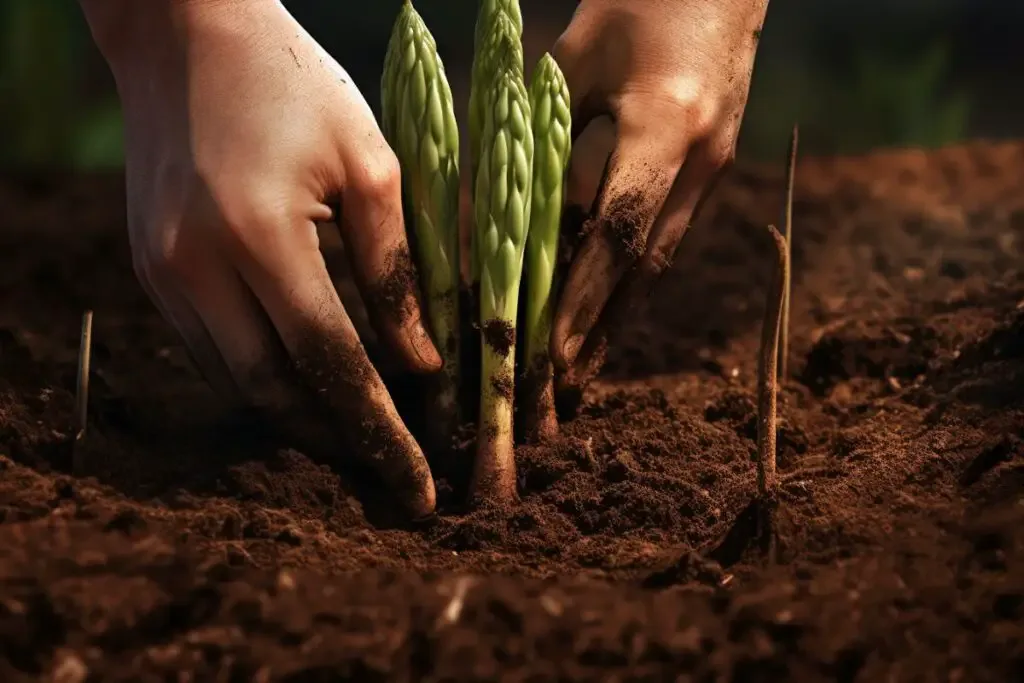
Planting asparagus correctly is crucial for a successful harvest. Follow these steps to get your asparagus off to a strong start:
- Choose the Right Location: Select a sunny spot in your garden with well-draining soil. Asparagus thrives in full sun, so aim for at least 6-8 hours of direct sunlight daily.
- Prepare the Soil: Asparagus prefers slightly acidic to neutral soil with a pH level between 6.0 and 7.0. Ensure the soil is rich in organic matter by incorporating compost or well-rotted manure into the planting area.
- Planting Depth: Dig a trench that is about 6-8 inches deep and wide. Place asparagus crowns (young plants) in the trench, spacing them 12-18 inches apart. Cover the crowns with 2-3 inches of soil initially, and gradually fill in the trench as the plants grow.
- Water Thoroughly: After planting, water your asparagus well to settle the soil around the crowns. Keep the soil consistently moist but not waterlogged during the growing season.
Light
As mentioned earlier, asparagus thrives in full sun. Ensure your asparagus patch receives ample sunlight to promote healthy growth and a bountiful harvest. Inadequate sunlight can result in weaker, spindly spears.
Soil
Maintaining the right soil conditions is vital for asparagus care. Here are some soil-related considerations:
- Well-Draining Soil: Asparagus roots can rot if the soil remains waterlogged for extended periods. Ensure your soil has good drainage to prevent this issue.
- Organic Matter: Incorporate organic matter like compost or well-rotted manure into the soil to enrich it and improve its structure.
- pH Levels: Check and adjust the soil pH to the recommended range of 6.0 to 7.0, as mentioned earlier.
Water
Proper watering is essential for asparagus, especially during the growing season. Here are some tips:
- Consistent Moisture: Asparagus plants require consistent moisture to produce healthy spears. Water deeply when the soil surface begins to dry, typically about once a week, depending on weather conditions.
- Mulching: Apply a layer of mulch around your asparagus plants to help retain moisture, suppress weeds, and maintain more even soil temperatures.
Temperature and Humidity
Asparagus is a hardy perennial, but it has temperature preferences:
- Cold Tolerance: Asparagus can withstand cold temperatures and even light frosts. In fact, a period of winter chill is necessary for its dormancy.
- Avoid High Humidity: While asparagus can tolerate some humidity, excessive moisture in the air can lead to fungal diseases. Adequate spacing between plants and good air circulation can help prevent these issues.
Fertilizer
Fertilizing asparagus is crucial for maintaining its long-term health and productivity:
- Early Spring: In early spring, before spears emerge, apply a balanced, slow-release fertilizer according to package instructions. This provides essential nutrients for the growing season.
- After Harvest: After the harvest season ends, provide another round of fertilizer to help nourish the plants for the next year’s growth.
Harvesting Asparagus
Harvesting asparagus is a rewarding task, and knowing when and how to do it is essential to ensure a continued and healthy yield. Here’s how to harvest your asparagus:
- First Harvest Year: In the first year after planting, avoid harvesting any spears to allow the plants to establish strong root systems.
- Second Year: In the second year, you can start harvesting when the spears reach about 6-8 inches in height. Use a knife or asparagus cutter to cut the spears just above the soil level. Harvest for 2-3 weeks in the spring.
- Subsequent Years: In subsequent years, you can extend the harvesting period to 6-8 weeks. Continue to harvest when the spears are the right size, and stop once they become thin and spindly.
- Late Spring: It’s crucial to stop harvesting asparagus spears by late spring to allow the plants to grow into tall, fern-like foliage. This ferny growth is essential for the plant’s energy storage, which will support next year’s harvest.
Pruning
Pruning asparagus is a straightforward process. After the growing season ends and the foliage turns brown, you can cut the dead foliage back to the ground. This helps prevent the overwintering of pests and diseases.
Propagating
Asparagus can be propagated by dividing established plants. To do this, dig up a mature plant in early spring before it starts to produce new growth. Carefully separate the crown into smaller sections, each with roots attached, and then replant these sections at the recommended spacing.
How to Grow Asparagus From Seed
While growing asparagus from seed is possible, it requires more time and patience compared to planting crowns. Here’s how to grow asparagus from seed:
- Start Indoors: Begin by sowing asparagus seeds indoors in early spring. Use seed trays or pots filled with seed-starting mix. Plant the seeds about 1/2 inch deep.
- Transplant Carefully: Once the seedlings have developed and are several inches tall, transplant them into your garden or larger pots. Be gentle with the delicate roots.
- Time to Harvest: Be prepared to wait longer for a harvest when growing from seed. It may take several years before your asparagus plants are established enough to produce spears for harvesting.
Growing in Pots
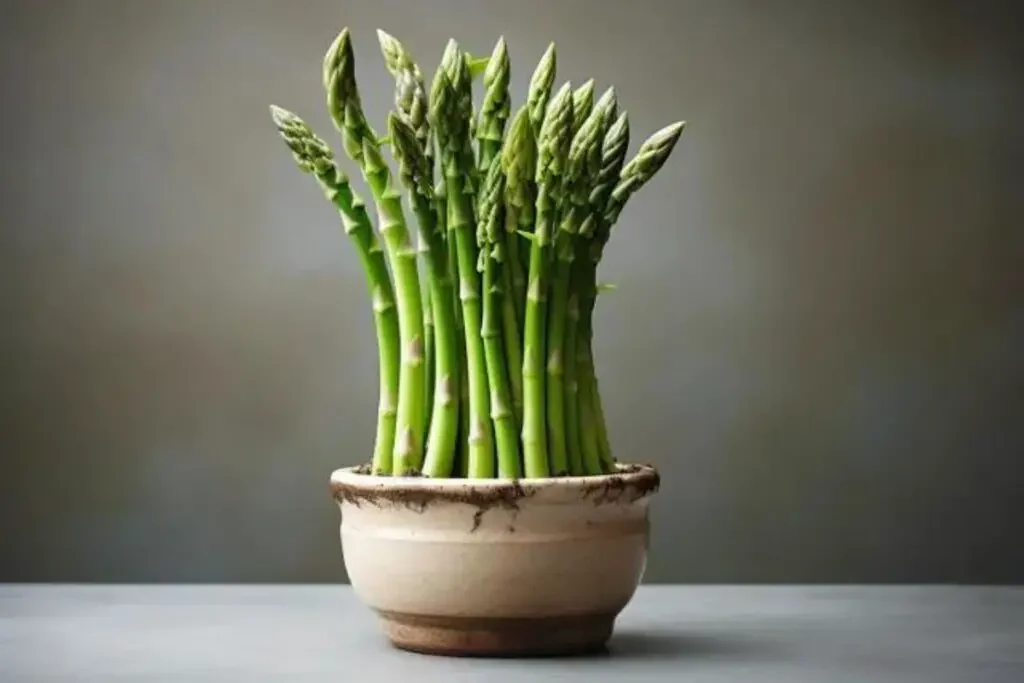
If you have limited space or want to grow asparagus on a patio or balcony, you can grow it in pots. Choose a large container (at least 18 inches deep) and fill it with a well-draining potting mix. Plant asparagus crowns or seedlings as you would in a garden bed, but ensure the pot receives full sun. Water and fertilize regularly to keep the plants healthy.
Overwintering
Asparagus is hardy and can survive cold winters, but you should take some precautions:
- Mulch: Apply a thick layer of mulch over the asparagus bed in late fall to help protect the crowns from freezing temperatures.
- Cut Back Foliage: After the foliage turns brown, cut it back to the ground and remove any dead debris to prevent overwintering pests and diseases.
Transplanting
If you need to move established asparagus plants, do so in early spring before new growth begins. Carefully dig up the plants, ensuring you get a good portion of the root system, and replant them in their new location following the same planting guidelines as for new asparagus crowns.
Common Pests & Diseases
Asparagus can face a few common pests and diseases, including asparagus beetles, aphids, and fusarium wilt. To manage these issues:
- Monitor Regularly: Keep an eye on your plants and inspect them regularly for signs of pests or disease.
- Organic Controls: Use organic pest control methods like hand-picking beetles, using insecticidal soap for aphids, and practicing good garden hygiene to prevent disease.
By following these guidelines for harvesting, pruning, propagating, and various other aspects of asparagus care, you’ll be well on your way to enjoying a thriving asparagus patch in your garden or even in pots on your patio.
Happy gardening!
